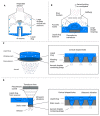Stability Considerations for Bacteriophages in Liquid Formulations Designed for Nebulization
- PMID: 37626867
- PMCID: PMC10453214
- DOI: 10.3390/cells12162057
Stability Considerations for Bacteriophages in Liquid Formulations Designed for Nebulization
Abstract
Pulmonary bacterial infections present a significant health risk to those with chronic respiratory diseases (CRDs) including cystic fibrosis (CF) and chronic-obstructive pulmonary disease (COPD). With the emergence of antimicrobial resistance (AMR), novel therapeutics are desperately needed to combat the emergence of resistant superbugs. Phage therapy is one possible alternative or adjunct to current antibiotics with activity against antimicrobial-resistant pathogens. How phages are administered will depend on the site of infection. For respiratory infections, a number of factors must be considered to deliver active phages to sites deep within the lung. The inhalation of phages via nebulization is a promising method of delivery to distal lung sites; however, it has been shown to result in a loss of phage viability. Although preliminary studies have assessed the use of nebulization for phage therapy both in vitro and in vivo, the factors that determine phage stability during nebulized delivery have yet to be characterized. This review summarizes current findings on the formulation and stability of liquid phage formulations designed for nebulization, providing insights to maximize phage stability and bactericidal activity via this delivery method.
Keywords: aerosolized delivery; antimicrobial resistance; bacteriophages; nebulization; respiratory infections.
Conflict of interest statement
The authors declare no conflict of interest.
Figures


References
-
- WHO . The Top 10 Causes of Death. WHO; Geneva, Switzerland: 2018.
-
- Pillarisetti N., Williamson E., Linnane B., Skoric B., Robertson C.F., Robinson P., Massie J., Hall G.L., Sly P., Stick S., et al. Infection, inflammation, and lung function decline in infants with cystic fibrosis. Am. J. Respir. Crit. Care Med. 2011;184:75–81. doi: 10.1164/rccm.201011-1892OC. - DOI - PubMed
Publication types
MeSH terms
Substances
LinkOut - more resources
Full Text Sources
Medical

